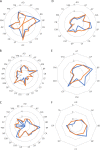Microbial Functional Responses to Cholesterol Catabolism in Denitrifying Sludge
- PMID: 30417110
- PMCID: PMC6208644
- DOI: 10.1128/mSystems.00113-18
Microbial Functional Responses to Cholesterol Catabolism in Denitrifying Sludge
Abstract
The 2,3-seco pathway, the pathway for anaerobic cholesterol degradation, has been established in the denitrifying betaproteobacterium Sterolibacterium denitrificans. However, knowledge of how microorganisms respond to cholesterol at the community level is elusive. Here, we applied mesocosm incubation and 16S rRNA sequencing to reveal that, in denitrifying sludge communities, three betaproteobacterial operational taxonomic units (OTUs) with low (94% to 95%) 16S rRNA sequence similarity to Stl. denitrificans are cholesterol degraders and members of the rare biosphere. Metatranscriptomic and metabolite analyses show that these degraders adopt the 2,3-seco pathway to sequentially catalyze the side chain and sterane of cholesterol and that two molybdoenzymes-steroid C25 dehydrogenase and 1-testosterone dehydrogenase/hydratase-are crucial for these bioprocesses, respectively. The metatranscriptome further suggests that these betaproteobacterial degraders display chemotaxis and motility toward cholesterol and that FadL-like transporters may be the key components for substrate uptake. Also, these betaproteobacteria are capable of transporting micronutrients and synthesizing cofactors essential for cellular metabolism and cholesterol degradation; however, the required cobalamin is possibly provided by cobalamin-de novo-synthesizing gamma-, delta-, and betaproteobacteria via the salvage pathway. Overall, our results indicate that the ability to degrade cholesterol in sludge communities is reserved for certain rare biosphere members and that C25 dehydrogenase can serve as a biomarker for sterol degradation in anoxic environments. IMPORTANCE Steroids are ubiquitous and abundant natural compounds that display recalcitrance. Biodegradation via sludge communities in wastewater treatment plants is the primary removal process for steroids. To date, compared to studies for aerobic steroid degradation, the knowledge of anaerobic degradation of steroids has been based on only a few model organisms. Due to the increase of anthropogenic impacts, steroid inputs may affect microbial diversity and functioning in ecosystems. Here, we first investigated microbial functional responses to cholesterol, the most abundant steroid in sludge, at the community level. Our metagenomic and metatranscriptomic analyses revealed that the capacities for cholesterol approach, uptake, and degradation are unique traits of certain low-abundance betaproteobacteria, indicating the importance of the rare biosphere in bioremediation. Apparent expression of genes involved in cofactor de novo synthesis and salvage pathways suggests that these micronutrients play important roles for cholesterol degradation in sludge communities.
Keywords: activated sludge; biodegradation; cholesterol; cobalamin; metatranscriptome; molydoenzyme; rare biosphere.
Figures








Similar articles
-
Microbial degradation of steroid sex hormones: implications for environmental and ecological studies.Microb Biotechnol. 2020 Jul;13(4):926-949. doi: 10.1111/1751-7915.13504. Epub 2019 Oct 30. Microb Biotechnol. 2020. PMID: 31668018 Free PMC article. Review.
-
Functional Characterization of Three Specific Acyl-Coenzyme A Synthetases Involved in Anaerobic Cholesterol Degradation in Sterolibacterium denitrificans Chol1S.Appl Environ Microbiol. 2018 Mar 19;84(7):e02721-17. doi: 10.1128/AEM.02721-17. Print 2018 Apr 1. Appl Environ Microbiol. 2018. PMID: 29374035 Free PMC article.
-
Four Molybdenum-Dependent Steroid C-25 Hydroxylases: Heterologous Overproduction, Role in Steroid Degradation, and Application for 25-Hydroxyvitamin D3 Synthesis.mBio. 2018 Jun 19;9(3):e00694-18. doi: 10.1128/mBio.00694-18. mBio. 2018. PMID: 29921665 Free PMC article.
-
Metagenomes Reveal Global Distribution of Bacterial Steroid Catabolism in Natural, Engineered, and Host Environments.mBio. 2018 Jan 30;9(1):e02345-17. doi: 10.1128/mBio.02345-17. mBio. 2018. PMID: 29382738 Free PMC article.
-
Upflow anaerobic sludge blanket reactor--a review.Indian J Environ Health. 2001 Apr;43(2):1-82. Indian J Environ Health. 2001. PMID: 12397675 Review.
Cited by
-
The Link Between the Ecology of the Prokaryotic Rare Biosphere and Its Biotechnological Potential.Front Microbiol. 2020 Feb 19;11:231. doi: 10.3389/fmicb.2020.00231. eCollection 2020. Front Microbiol. 2020. PMID: 32140148 Free PMC article. Review.
-
Retroconversion of estrogens into androgens by bacteria via a cobalamin-mediated methylation.Proc Natl Acad Sci U S A. 2020 Jan 21;117(3):1395-1403. doi: 10.1073/pnas.1914380117. Epub 2019 Dec 17. Proc Natl Acad Sci U S A. 2020. PMID: 31848239 Free PMC article.
-
Biogas digestate as a sustainable phytosterol source for biotechnological cascade valorization.Microb Biotechnol. 2023 Feb;16(2):337-349. doi: 10.1111/1751-7915.14174. Epub 2022 Nov 22. Microb Biotechnol. 2023. PMID: 36415958 Free PMC article.
-
Microbial degradation of steroid sex hormones: implications for environmental and ecological studies.Microb Biotechnol. 2020 Jul;13(4):926-949. doi: 10.1111/1751-7915.13504. Epub 2019 Oct 30. Microb Biotechnol. 2020. PMID: 31668018 Free PMC article. Review.
-
Integrated Multi-omics Investigations Reveal the Key Role of Synergistic Microbial Networks in Removing Plasticizer Di-(2-Ethylhexyl) Phthalate from Estuarine Sediments.mSystems. 2021 Jun 29;6(3):e0035821. doi: 10.1128/mSystems.00358-21. Epub 2021 Jun 8. mSystems. 2021. PMID: 34100638 Free PMC article.
References
LinkOut - more resources
Full Text Sources
Molecular Biology Databases

